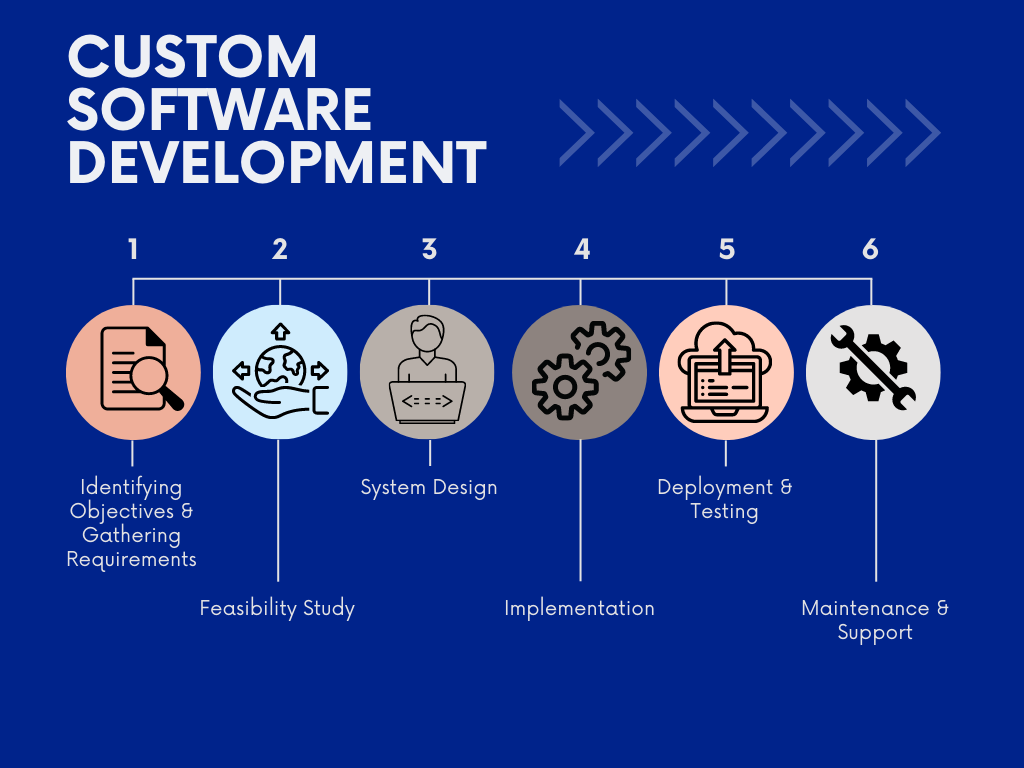Custom Software Application Advancement: Tailoring Technology to Meet Your One-of-a-kind Requirements
In today's rapidly progressing technological landscape, custom software development stands as an essential approach for services seeking to refine their procedures with precision-crafted remedies. Unlike common applications, customized software program aligns very closely with details organization needs, driving performance and competitiveness. The process of crafting these options involves careful preparation and partnership, guaranteeing that every functional requirement is dealt with. As ventures aim for seamless integration and scalability, the concern occurs: exactly how does one ensure that custom software application not only satisfies present needs yet additionally expects future obstacles? This exploration assures understandings right into the critical value of bespoke innovation services.
Understanding Customized Software Program
Custom software application growth includes crafting tailored software application options to fulfill the certain needs of a company or organization, differentiating it from off-the-shelf software application. While off-the-shelf solutions give generic capabilities designed for mass appeal, custom software is carefully developed to fit the unique procedures, workflows, and critical goals of a specific entity. The growth of custom-made software application is an intricate procedure that requires a deep understanding of the customer's needs and the environment in which the software will operate.
The procedure begins with a detailed evaluation of the customer's service procedures to identify particular requirements and difficulties that the software program have to address. This is complied with by the layout and advancement phases, where software designers and designers function closely with stakeholders to guarantee positioning with company objectives. Unlike common software, custom-made software application is adaptable, permitting adjustments and scalability as the company progresses.
Moreover, personalized software is established with the organization's existing systems in mind, ensuring integration and compatibility throughout platforms. This causes boosted performance and structured operations. By lining up modern technology with business procedures, custom-made software application equips companies to accomplish their objectives with precision and effectiveness, inevitably giving an one-upmanship in their particular sectors.
Advantages of Tailored Solutions

Moreover, customized software application offers scalability, an essential advantage for growing companies. As a firm's needs evolve, custom-made remedies can be readjusted and broadened to accommodate new performances without disrupting existing procedures. This flexibility makes certain lasting stability and supports future growth.
Security is an additional substantial benefit. Custom software can be made with robust safety and security methods tailored to the go to this website particular susceptabilities of the organization, decreasing the danger of cyber threats. Unlike common software, which may be targeted by widespread assaults, customized options provide a much less predictable target for cybercriminals.
Key Advancement Processes
Comprehending the advantages of customized software services lays the foundation for discovering the essential growth procedures that make such customization feasible. Central to these processes are needs gathering, design, growth, testing, and deployment. Each step is thoroughly crafted to ensure that the i loved this final product lines up effortlessly with the customer's unique objectives.
The process begins with detailed needs collecting, where designers take part in detailed conversations with stakeholders to understand their details requirements and constraints. This stage is important for identifying the software program's extent and establishing clear assumptions. Following this, the design stage converts these requirements into a critical plan, laying out the software program's style, interface, and capabilities.
Development is the core of the procedure, where knowledgeable developers create code based on the established layout. This stage is repetitive, enabling continuous improvement and assimilation of comments. Checking adheres to, acting as a high quality guarantee step to identify and correct any kind of defects or disparities.
Collaboration With Developers
Effective partnership with designers is vital to the success of customized software application tasks. It includes routine conferences, transparent discussions, and utilizing devices that promote pop over to these guys details exchange, such as project administration software and communication systems.
Recognizing the programmer's workflow is also vital. Clients that acquaint themselves with the advancement procedure can give even more pertinent comments and established realistic assumptions relating to timelines and deliverables. This good understanding cultivates an extra unified partnership, where programmers feel supported and clients feel educated.
Moreover, entailing developers early in the decision-making process can significantly boost the job's outcome. Developers bring technical experience that can affect tactical decisions, making sure that recommended options are not only feasible but also efficient. By valuing their input, clients can harness their imagination and technical skills to achieve innovative results.
Future-Proofing Your Software
In the ever-evolving landscape of modern technology, ensuring your custom software remains pertinent and useful gradually is paramount (custom software development). Future-proofing your software program involves strategic preparation and execution of adaptable remedies that fit technical improvements and altering organization demands. The key is to prepare for prospective changes and incorporate flexibility into your software program design from the start
To accomplish this, focus on scalable remedies that permit seamless assimilation of new features or modules as your organization expands. Employing modular style patterns can promote updates and reduce disruptions. In addition, embracing open requirements and interoperability makes sure that your software application can communicate successfully with other systems, staying clear of vendor lock-in and enhancing adaptability.
On a regular basis upgrading your modern technology stack is likewise vital. This entails remaining notified regarding emerging innovations and industry fads, allowing your software to take advantage of the current innovations. Positive upkeep and rigorous testing procedures are crucial to determine and address susceptabilities, guaranteeing continual safety and security and efficiency.

Conclusion
Custom-made software development uses a strategic advantage by giving services distinctly customized to an organization's certain needs, improving operational performance, scalability, and safety. Via thorough demands collecting, collaborative style, and repetitive growth, custom software application makes certain smooth assimilation with existing systems and flexibility to future modifications. This method not only addresses existing obstacles but likewise settings services for lasting success by progressing alongside organizational growth, thus establishing a durable foundation for continual technical development and competitive edge.